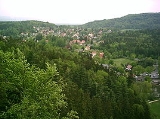
Jonsdorf
Encyclopedia
The community of Jonsdorf is located in the south of the Kreis Görlitz in the southeast of the German federal state of Saxony
. It is embedded into a valley of the Zittau Mountains, part of the Lusatian Mountains
.
. In 1547 the whole land of Oybin had been sold to the city of Zittau
by Maximilian the Second.
In 1580 Hieronymus Richter established the first sandstone quarry inside the rock formations surrounding Jonsdorf to produce millstones. Some decades later, in 1667, the city-council of Zittau decided to found some additional quarries in the district between Jonsdorf and Waltersdorf. The production of millstone ended in 1917.
In the next years the two villages grew. After cutting down a forest between the villages of old and new Jonsdorf in 1731, both parts of the villages were unified. The construction of a church in Jonsdorf started in the same year.
Like many other villages and towns in Upper Lusatia
, Jonsdorf established a special kind of industry in the 18th and 19th century - the weaving of linen. The first touristic development in the village started in 1841 when Karl Linke opened the first cold water cure house (Kaltwasseranstalt) applying hydrotherapy. The spa-tourism became more and more important in the years later. In 1890 a narrow-gauge railway link was opened between Zittau and Jonsdorf
and helped the village to flourish.
After the end of World War II and the arrival of expelled Sudeten Germans
from Bohemia, a small development programme was set up that included the construction of an icedome and a forest theatre in the 1950s. In 1984 a new school was opened. New projects after the reunification of Germany improved the economical structure even further. A leisure centre with an ice rink went into operation in 1996, and in 2004 a butterfly house (Schmetterlingshaus) was opened.
Saxony
The Free State of Saxony is a landlocked state of Germany, contingent with Brandenburg, Saxony Anhalt, Thuringia, Bavaria, the Czech Republic and Poland. It is the tenth-largest German state in area, with of Germany's sixteen states....
. It is embedded into a valley of the Zittau Mountains, part of the Lusatian Mountains
Lusatian Mountains
The Lusatian Mountains are a mountain range of the Western Sudetes, located on the southeastern border of Germany with the Czech Republic east of the Elbe river, a continuation of the Ore Mountains range west of the Elbe valley...
.
History
In 1539 Jonsdorf was first mentioned in a documentary which showed the selling of land to ten new settlers by the monastery of OybinOybin
Oybin is a municipality in the district Görlitz, in Saxony, Germany, located very close to the border of the Czech Republic. Following the defeat of the Protestant armies by the Habsburgs in the Battle of the White Mountain in 1620, many Protestant Czechs found refuge across the border in the...
. In 1547 the whole land of Oybin had been sold to the city of Zittau
Zittau
Zittau is a city in the south east of the Free State of Saxony, Germany, close to the border tripoint of Germany, Poland, and the Czech Republic. , there are 28,638 people in the city. It is part of the Görlitz district....
by Maximilian the Second.
In 1580 Hieronymus Richter established the first sandstone quarry inside the rock formations surrounding Jonsdorf to produce millstones. Some decades later, in 1667, the city-council of Zittau decided to found some additional quarries in the district between Jonsdorf and Waltersdorf. The production of millstone ended in 1917.
In the next years the two villages grew. After cutting down a forest between the villages of old and new Jonsdorf in 1731, both parts of the villages were unified. The construction of a church in Jonsdorf started in the same year.
Like many other villages and towns in Upper Lusatia
Upper Lusatia
Upper Lusatia is a region a biggest part of which belongs to Saxony, a small eastern part belongs to Poland, the northern part to Brandenburg. In Saxony, Upper Lusatia comprises roughly the districts of Bautzen and Görlitz , in Brandenburg the southern part of district Oberspreewald-Lausitz...
, Jonsdorf established a special kind of industry in the 18th and 19th century - the weaving of linen. The first touristic development in the village started in 1841 when Karl Linke opened the first cold water cure house (Kaltwasseranstalt) applying hydrotherapy. The spa-tourism became more and more important in the years later. In 1890 a narrow-gauge railway link was opened between Zittau and Jonsdorf
Zittau-Oybin-Jonsdorf line
The Zittau–Oybin–Jonsdorf railway is a narrow gauge railway system employing steam locomotives and serving the mountain spa resorts of Oybin and Jonsdorf in the Zittau Mountains in southeast Saxony . The track gauge is .-Literature:* Gustav W...
and helped the village to flourish.
After the end of World War II and the arrival of expelled Sudeten Germans
Sudeten Germans
- Importance of Sudeten Germans :Czechoslovakia was inhabited by over 3 million ethnic Germans, comprising about 23 percent of the population of the republic and about 29.5% of Bohemia and Moravia....
from Bohemia, a small development programme was set up that included the construction of an icedome and a forest theatre in the 1950s. In 1984 a new school was opened. New projects after the reunification of Germany improved the economical structure even further. A leisure centre with an ice rink went into operation in 1996, and in 2004 a butterfly house (Schmetterlingshaus) was opened.

